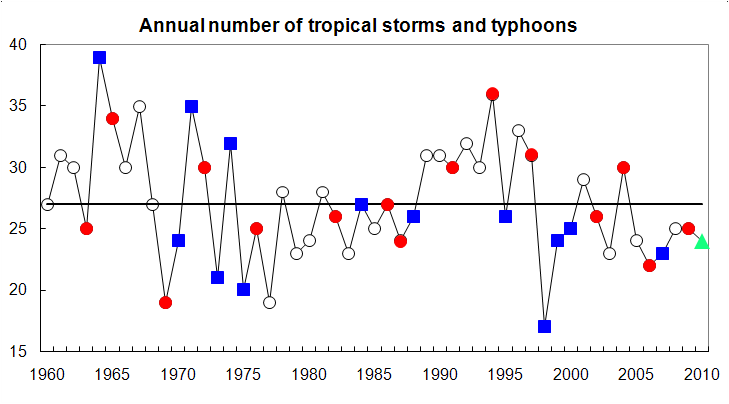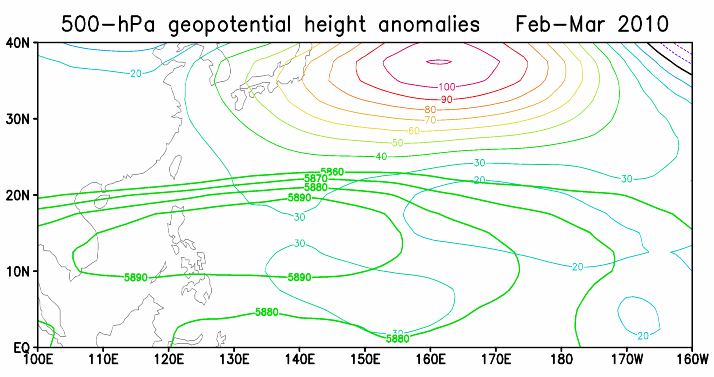|
2010
Predictions
of Seasonal Tropical Cyclone Activity over the Western North Pacific
Real-time predictions of the annual number of tropical
cyclones (TCs) affecting the western North Pacific (WNP) and the South China Sea
(SCS) were first issued in 2000 by the
Laboratory for Atmospheric Research (LAR)
at City University of Hong Kong (CityU) and annually thereafter until 2008 when
such predictions were issued by the
Guy Carpenter Asia-Pacific
Climate Impact Centre, also at CityU.
Verifications of the predictions for the past
ten years have shown that the predictions are mostly correct within the error
bars.
These are all statistical
predictions with predictors drawn from a large group of indices that represent
the atmospheric and oceanographic conditions in the previous year up to the
spring of the current year. The most prominent ones include the proxies for El
Niño/Southern Oscillation (ENSO), the extent of the subtropical ridge, and the
intensity of the India-Burma trough. Details can be found in
Chan et al. (1998, 2001) and Liu
and Chan (2003).
2. ENSO conditions in 2010
As an important determinant is the status
of the ENSO condition, it is useful to have a discussion on the possible ENSO
situation in 2010. A moderate
El Niño event has developed in the summer of 2009. In March,
SSTs remain warmer than normal in the central and east equatorial Pacific
Ocean. The Niño3.4 and Niño4 index in March are 1.14 and 1.12 respectively. A
summary of the various ENSO
model forecasts from different climate centres
suggests that El Niño is likely to continue through
the spring and a transition to ENSO-neutral condition is expected during the
summer (Table. 1). Based
on these results, it appears that 2010 will likely be an ENSO-neutral year.
3. Predictions for the WNP
The ENSO predictor (NINO4 index)
suggests a below-normal overall TC activity while the other predictors give a
below-normal or a near-normal activity (Table 2). The
final forecast is therefore for a below-normal overall TC activity (28 tropical
cyclones).
For the number of tropical storms
and typhoons, most of the predictors consistently forecast a below-normal
activity (ranging from 24 to 26) and therefore a below-normal TC activity (24
tropical storms and typhoons) is expected for this category (Fig.
1).
A slightly difference between non-ENSO
and ENSO predictors is found for the number of typhoons.
The ENSO predictors (NINO3.4 index and equatorial SOI index) suggest a
near-normal TC activity (predicted numbers being 17 and 18 respectively) while
the other predictors forecast a below-normal to near-normal TC activity, with
predicted numbers ranging from 14 to 17. Therefore, the final forecast is 16
typhoons, which is near the normal number.
Thus, it is expected that the
overall TC activity as well as the number of tropical storms and typhoons are
likely to be below-normal while the number of typhoons is likely to be
near-normal. The quantitative predictions are given in
Table 2.
The predictor related to the
subtropical high (HWNP) suggests a
below-normal TC activity. Such
forecasts are partly based on the stronger-than-normal subtropical high observed
between February and March in 2010 (Fig. 2). If
this situation continues, the atmospheric condition will be less favorable for
tropical cyclone formation. This is consistent with the predicted less active
TC season in 2010.
The possible error in the current
predictions is given by an envelope of the possible errors, which are based on
the predictions from individual predictors. The smallest and largest numbers
among the individual predictions may be considered as the lower and upper bound
of the final predictions. A larger (smaller) difference between the lower and
upper bound might then indicate lower (higher) predictability. Based on this
concept, we could see that for this year, prediction for the number of tropical
storms and typhoons has the smallest spread and thus the highest predictability.
As discussed in Chan et al. (2001), we will provide an
updated forecast sometime in June.
Summary
of predictions
|
|
Forecast |
Normal |
|
Entire western North Pacific |
|
All TC |
28
(below normal) |
31 |
|
Tropical storms
and typhoons |
24
(below normal) |
27 |
|
Typhoons |
16
(near normal) |
17 |
|
MODEL /
GROUP |
1-4 MONTHS
(Apr-Aug) |
4-7 MONTHS
(Aug-Oct) |
|
POAMA
Australian Bureau of Meteorology |
Neutral |
Neutral |
|
System 3
ECMWF (EU) |
Neutral |
Neutral |
|
GloSea
UK Met Office |
Warm
/
Neutral |
Neutral |
|
CFS
NCEP (US) |
Warm
/
Neutral |
Neutral |
|
CGCMv1
NASA Goddard GMAO (US) |
Neutral |
Neutral |
|
JMA-CGCM02
Japan Met. Agency |
Warm
/
Neutral |
Neutral |
KMA-SNU
Korean Met. Administration |
Warm
/
Neutral |
Neutral |
|
Table
2. |
Forecasts
from various predictors and the weighted average of the forecasts. |
|
Entire
western North Pacific |
|
All
TC |
|
HWNP |
HIB |
NINO4 |
|
Final forecast |
Normal
|
|
Prediction |
30 |
28 |
25 |
|
28 |
31 |
|
Weight |
0.65 |
0.68 |
0.70 |
|
|
|
|
|
Tropical
storms and typhoons |
|
HWNP |
HIB |
WP |
NINO3.4 |
Final forecast |
Normal
|
|
Prediction |
24 |
26 |
24 |
24 |
24 |
27 |
|
Weight |
0.68 |
0.64 |
0.49 |
0.68 |
|
|
|
|
Typhoons |
|
HWNP |
HIB |
WP |
NINO3.4 |
ESOI |
Final forecast |
Normal
|
|
Prediction |
14 |
17 |
15 |
17 |
18 |
16 |
17 |
|
Weight |
0.64 |
0.58 |
0.59 |
0.77 |
0.67 |
|
|
|
| |
| HWNP |
Index of the westward extent of the subtropical high
over the western North Pacific |
| HIB |
Index of the strength of the India-Burma trough
(15o-20oN, 80o-120oE) |
| WP |
Primary mode of low-frequency variability over the North Pacific |
| NINO3.4 |
Sea surface temperature (SST) anomalies in the NINO3.4 region
(5oS-5oN,
170o-120oW) |
| NINO4 |
Sea surface temperature (SST) anomalies in the NINO4 region
(5oS-5oN, 160oE-150oW) |
| ESOI |
Equatorial Southern Oscillation Index (Equatorial
SOI)
Equatorial Eastern Pacific SLP - Indonesia SLP (standardized anomalies) |
|

Fig. 1.
|
Time series of the annual number of tropical storms and
typhoons. Red circle and blue squares indicate the El Niño
and La Niña years respectively.
The thick
horizontal line indicates the normal number of tropical storms and typhoons.
The green
triangle indicated the predicted number in 2010. |

Fig. 2.
|
500-hPa
geopotential height anomalies between February and March in 2010. Thick
contours indicate the geopotential height (contour interval = 10 m)
³
5860 m. |
References
Chan, J. C. L., J. E. Shi and C. M. Lam,
1998: Seasonal forecasting of tropical cyclone activity over the western North Pacific and
the South China Sea. Weather Forecasting, 13, 997-1004.
Abstract
Chan, J. C. L., J. E. Shi and K. S. Liu, 2001:
Improvements in the seasonal forecasting of tropical cyclone activity over the western
North Pacific. Weather Forecasting, 16,
491-498. Abstract
Liu,
K. S. and J. C. L. Chan, 2003: Climatological
characteristics and seasonal forecasting of tropical cyclones making landfall
along the South China coast.
Monthly
Weather Review, 131,
1650-1662. Abstract
|